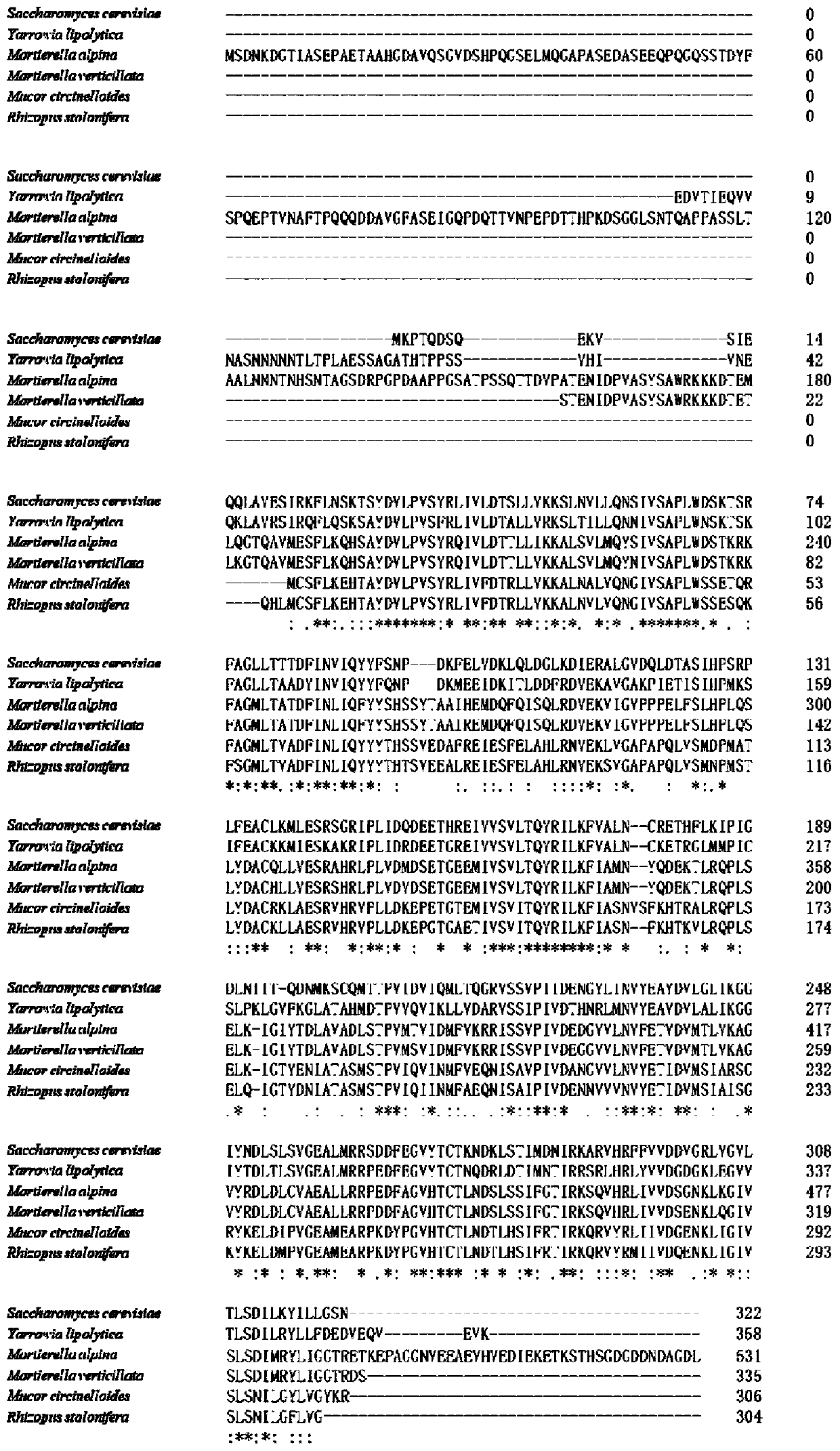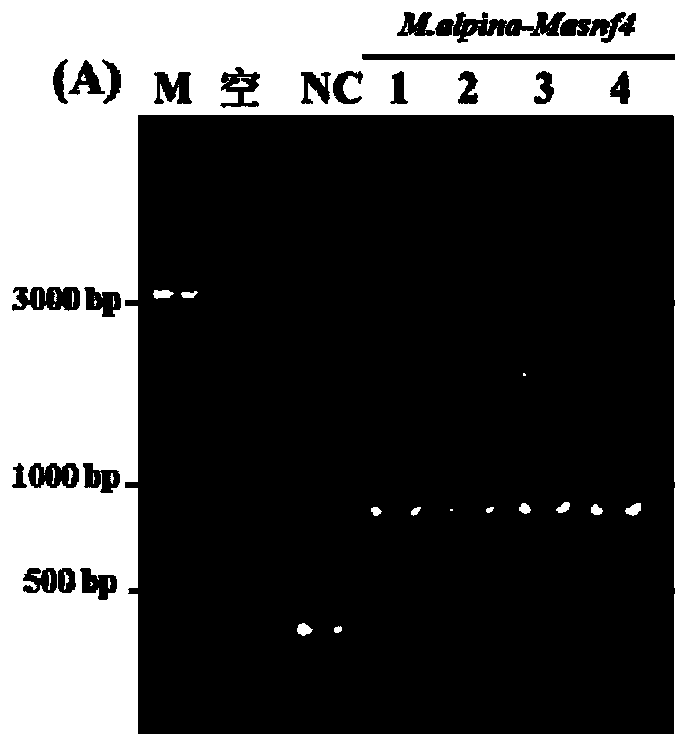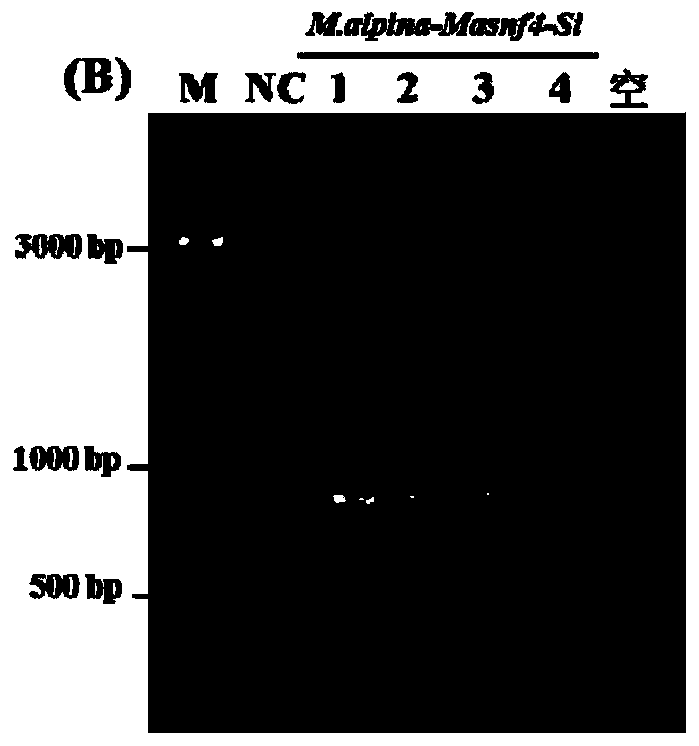Cane sugar non-fermentation type protein kinase regulatory subunit and application thereof
A protein kinase and regulatory subunit technology, applied in the fields of genetic engineering and microbial engineering, can solve the problem of less functional analysis of the SNF1 complex and achieve the effect of reducing production costs
- Summary
- Abstract
- Description
- Claims
- Application Information
AI Technical Summary
Problems solved by technology
Method used
Image
Examples
Embodiment 1
[0047] Example 1: Screening of genes encoding regulatory subunits of sucrose nonfermenting protein kinases
[0048] According to the gene sequence of the sucrose non-fermenting protein kinase regulatory subunit whose function has been identified in NCBI as a template, perform BLAST comparison in the gene bank of the sequenced M.alpina ATCC 32222 strain to obtain an alternative target gene; then Alternative target gene is carried out secondary alignment screening in NCBI storehouse, the target protein that finally obtains is named as Masnf4 (amino acid sequence is as shown in SEQ ID No.1), and its coding gene is named as Masnf4 (nucleotide sequence As shown in SEQ ID No.2).
[0049] The full length of Masnf4 corresponding cDNA is 1596bp, encoding 531 amino acids. In order to further determine whether the screened Masnf4 belongs to the regulatory subunit of sucrose non-fermenting protein kinase, the amino acid homology and conserved structure analysis was carried out with the A...
Embodiment 2
[0057] Example 2: Cloning of Masnf4
[0058] The total RNA of Mortierella alpina (Mortierella alpina) ATCC 32222 was extracted using the Trizol method, and cDNA was obtained by reverse transcription according to the instructions of the Takara reverse transcription kit. The reaction amplifies Masnf4, and the primers used for amplifying Masnf4 are listed in Table 2.
[0059] The PCR instrument used is BIO-RAD T100 Thermal Cycler, using KOD plus high-fidelity DNA polymerase, the reaction system is 50 μL, and the content of the system is carried out according to the instructions of the DNA polymerase; the reaction process is as follows: pre-denaturation at 95°C for 5 minutes, then denaturation at 95°C 30s, annealing at 58°C for 30s, extension at 68°C for 1.5min, repeat the above three steps 30 times, then fully extend at 68°C for 7min, and finally drop to 4°C for 10min and stop.
[0060] After the reaction is completed, the amplified product is obtained, and after the amplified p...
Embodiment 3
[0064] Example 3: Expression and RNA interference of Masnf4 in Mortierella alpina
[0065] (1) Construction of Mortierella alpina expression vector
[0066] Masnf4 obtained in Example 2 and the expression vector pBIG2-ura5s-ITs were digested using restriction endonucleases HindⅢ and SmaI, and then T 4 Ligase ligated the digested and purified DNA to obtain a ligation product. The specific enzyme digestion system (20 μL) is shown in Table 3.
[0067] Table 3 enzyme digestion system
[0068] Reagent Dosage 10×cutmart buffer 2μL restriction endonuclease 1μL PCR product or vector 200ng or 1μg wxya 2 o
Make up to 20μL
[0069] After connecting the obtained ligation product overnight at 4-16°C, transform it into Escherichia coli DH5α competent cells. The transformation method is as follows: take 100 μL of competent cells in a sterile state, add 5-8 μL of the ligation product, and mix by pipetting; Transfer the mixed competent cells i...
PUM
 Login to View More
Login to View More Abstract
Description
Claims
Application Information
 Login to View More
Login to View More - R&D
- Intellectual Property
- Life Sciences
- Materials
- Tech Scout
- Unparalleled Data Quality
- Higher Quality Content
- 60% Fewer Hallucinations
Browse by: Latest US Patents, China's latest patents, Technical Efficacy Thesaurus, Application Domain, Technology Topic, Popular Technical Reports.
© 2025 PatSnap. All rights reserved.Legal|Privacy policy|Modern Slavery Act Transparency Statement|Sitemap|About US| Contact US: help@patsnap.com



